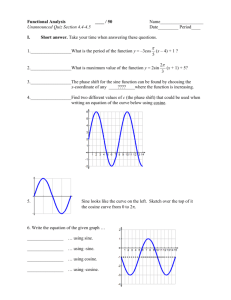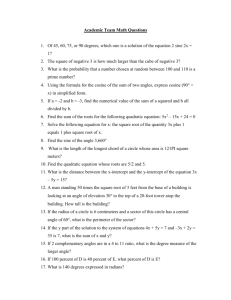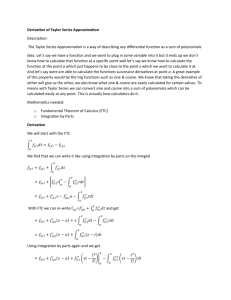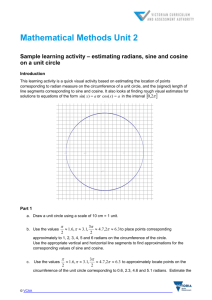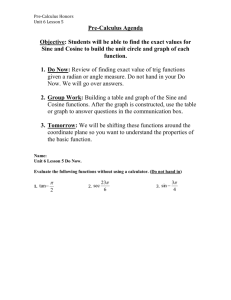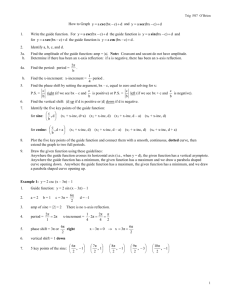Graphing Transformations on Sine and Cosine
advertisement
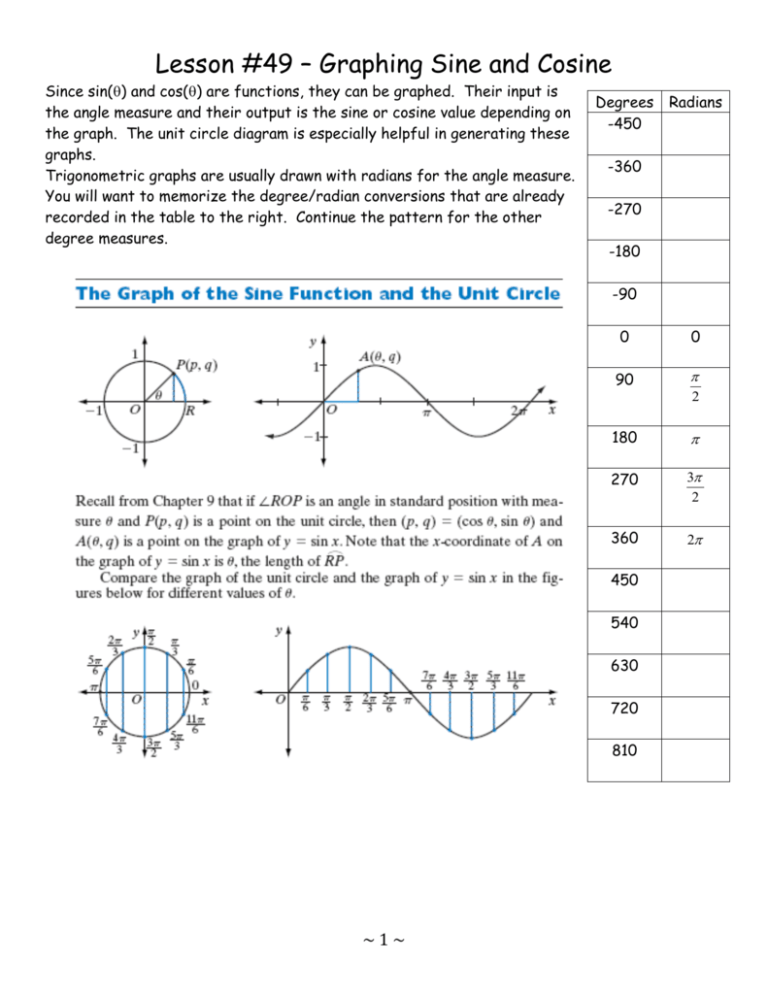
Lesson #49 – Graphing Sine and Cosine Since sin() and cos() are functions, they can be graphed. Their input is the angle measure and their output is the sine or cosine value depending on the graph. The unit circle diagram is especially helpful in generating these graphs. Trigonometric graphs are usually drawn with radians for the angle measure. You will want to memorize the degree/radian conversions that are already recorded in the table to the right. Continue the pattern for the other degree measures. Degrees -450 Radians -360 -270 -180 -90 0 0 90 2 180 270 3 2 360 2 450 540 630 720 810 ~1~ Using the chart, create a graph for y=sin on the interval 0 2 . Use the unit circle to find the sine values for the quadrantal angles. Extend the pattern so that 3 Input Output Sin 0 2 3 2 2 a) What is the domain of y=sinθ? Suggested Scales when graphing y=sin(x) and y=cos(x) x-axis: 2 spaces is (90°). 2 y-axis: 2 spaces is 1 b) What is the range of y=sinθ? c) Is sinθ a 1-to-1 function? Justify your answer. d) What is the y-intercept of y=sinθ? e) What is the maximum value of y=sinθ? f) What is the minimum value of y=sinθ? g) The distance from the x-axis (midline) to the maximum value of sinθ is known as the amplitude. What is the amplitude of y=sinθ? h) The period of a trig. function is the interval length of one complete cycle of the graph. What is the period of y=sinθ? ~2~ 1. 2. 3. 4. Graphing trigonometric functions on the calculator Make sure your calculator is in RADIAN mode. Type the function in Y1. Press Zoom and choose #7, Zoomtrig. If you press window Window: Xmin: -6.15 . . . Xmax: 6.15 . . . XScl: 1.57. . . Ymin: -4 Ymax: 4 Y-scl: 1 Window in terms of π: Xmin: about -2π Xmax: about 2π XScl: exactly 2 Ymin: -4 Ymax: 4 Y-scl: 1 5. Adjust the X-min and X-max to fit the specified interval such as 0 2 ~3~ Using the chart, create a graph for y=cos on the interval 0 2 . Use the unit circle to find the cosine values for the quadrantal angles. Extend the pattern so that 3 Input Output Cos 0 2 3 2 2 a) What is the domain of y=cosθ? b) What is the range of y=cosθ? c) Is y=cosθ a 1-to-1 function? Justify your answer. d) What is the y-intercept of y=cosθ? e) What is the maximum value of y=cosθ? f) What is the minimum value of y=cosθ? g) The distance from the x-axis to the maximum value of y=cosθ is known as the amplitude. What is the amplitude of y=cosθ? i) The period of a trig. function is the interval length of one complete cycle of the graph. What is the period of y=cosθ? Summary for checking trig graphs on your calculator 1. 2. 3. 4. Make sure you are in radian mode unless the problem indicates degree mode. Type in Y= Press ZoomTrig Adjust the Window manually if the interval is not 2 2 . 5. Graph the function. The x-scale should go by (usually for every 2 spaces) and the y2 scale should go by 1 to match your calculator. ~4~ Lesson #50 – Graphs of Tangent and the Reciprocals A2.A.71 Sketch and recognize the graphs of the functions y=sec x, y = csc x, y = tan x, y = cot x Note: The four functions we are working with today can be written as rational expressions with sine, cosine or both because they are the quotient and reciprocal functions. 1 What are the restricted values for f ( x) ? x What are the restricted values for g ( x) 1 ? x2 Vertical asymptotes are vertical lines which correspond to the zeroes of the denominator of a rational function. The graph of the function gets closer and closer to these lines, but it will never touch or cross the line. Draw a sketch of g(x) using your calculator. Draw a vertical asymptote at x = -2. What are the restricted values for f ( x) csc( x) 1 ? (You can use the unit circle to sin( x) help you answer this question). Note: If you have a TI-83 calculator, it incorrectly tries to connect the infinity to the negative infinity which creates a vertical line that is not really part of the graph. You can 1 see this with the graph of f ( x) . TI-84 calculators do not make this error. x2 Steps: 1. Use the unit circle to find the trig. values for the quadrantal angles. Use a table. 2. Draw the vertical asymptotes where the function is undefined. 3. Plot the other points. 4. Use your calculator as a guide to sketch the rest of the graph. Make sure you are in radian mode and use #7: ZoomTrig. ~5~ Graph for y=csc. Use the unit circle to find the cosecant values for the quadrantal angles. Extend the pattern so that 2 2 Input Output csc a) What is the domain of y=cscθ? b) What is the range of y=cscθ? Graph y=sec. Use the unit circle to find the secant values for the quadrantal angles. Extend the pattern so that 2 2 Input Output sec a) What is the domain of y=secθ? b) What is the range of y=secθ? ~6~ Graph for y=tan. Use the unit circle to find the tangent values for the quadrantal angles. Extend the pattern so that 2 2 Input Output tan c) What is the domain of y=tanθ? d) What is the range of y=tanθ? Graph y=cot. Use the unit circle to find the cotangent values for the quadrantal angles. Extend the pattern so that 2 2 Input Output cot c) What is the domain of y=cotθ? d) What is the range of y=cotθ? ~7~ Lesson #51 – Transformations on Sine and Cosine A2.A.69 Determine amplitude, period, frequency, and phase shift, given the graph or equation of a periodic function A2.A.70 Sketch and recognize one cycle of a function of the form y =A sinBx or y=AcosBx A2.A.72 Write the trigonometric function that is represented by a given periodic graph Fill in the table below. 1-5 are review from last unit. 6 is a new transformation. Function Notation 1. -f(x) 2. f(-x) 3. af(x) Transformation 0 < a < 1: a > 1: 4. f(x+a) +a: -a: 5. f(x)+a +a: -a: 6. f(ax) 0 < a < 1: a > 1: Why do horizontal changes (4 and 6) work the opposite of what you would think? Do the examples below to find out. When answering the questions, think of a value for a such as 2. If I want the value of x to be increased by a, show x=5 would you would have to do to x y=5 If I want the value of y to be increased by a, show would you would have to do to y. Solve for y. x=5 If you want the value of x to be multiplied by a, show would you would have to do to x. y=5 If you want the value of x to be multiplied by a, show would you would have to do to y. Solve for y. The above chart is showing that you need to perform the inverse operation on the variable so that the desired change happens when you solve for the variable. With functions, we solve for y. Therefore the change ends up being the operation you would expect. We do not solve for x, so you still see the inverse operation with x. ~8~ The transformations we will be doing on sine and cosine are bolded and underlined in the table on the previous page. For each of the following equations identify the transformation(s) on that have occurred on either sine or cosine. Note: When working with trigonometric functions, horizontal shifts (left or right) are referred to as phase shifts when the equation is in the form y=asin(b(x+c)) or y=acos(b(x+c)). Use this term when completing the section below. 1. y 5sin 3 x 1 2. y 2 cos x 2 3. y 3sin x 4. y cos 2 x 5. y 100cos 3 x 2 2 6. y cos 7 x 3 7. y sin x 6 x 8. y = cos 5 4 ~9~ Tricky! Amplitude, Period, and Frequency Amplitude: The height of the a trigonometric function from the midline to its maximum y-value. The amplitude is equal to the vertical stretch/compression. Period: The length of one cycle The period is equal to divided by the horizontal compression/stretch. Frequency: The number of cycles (periods) from 0 to . The frequency is equal to the horizontal compression/stretch. Example: y = 5cos(3x) The amplitude is 5. The parent cosine curve has an amplitude of 1, so a vertical stretch of 5 would result in an amplitude of 5. The period is 2 . The parent cosine curve has a period of 2 . Since this graph is 3 horizontally compressed by 3, the period will become 3 times shorter. The frequency of this graph is 3. The parent cosine curve has a frequency of 1. Since this graph is horizontally compressed by 3, there will be 3 cosine curves over the interval from 0 to 2 . y = Asin(B(x+C)) or y = Acos(B(x+C)) Amplitude = |A| Period = 2 B Frequency = B Phase Shift = C Go back to the previous page and identify the amplitude, period, and frequency of each of the functions. ~ 10 ~ Graphing Transformations on Sine and Cosine Graph one period of y=sinx and y=cosx. Use the unit circle to make your table. These tables and graphs are the starting point for every transformation on sine or cosine. If you do not know how to graph them, the rest of this lesson will be very difficult. y=sinx x y=cosx y x y For this course, you only have to graph one period of transformations of sine and cosine in the form y=AsinBX or y=AcosBx. Steps 1. Start with one of the basic tables for either sine or cosine. 2. A will result in a vertical stretch/compression. Multiply the y-values by A. 3. B will result in a horizontal compression/stretch. Since a horizontal compression/stretch works in the opposite from the way you would expect, you need to divide the x-values by B. 4. A negative in front of the equation means the function was reflected over the x-axis. Therefore negate the y-values. Scales For trig. graphs, we typically label the x-axis with 2 for every 2 spaces.. For transformations, it is easiest to label the x-axis with 2 for every 2 spaces instead. B Adjust the interval on the y-axis based on the value of A if necessary. ~ 11 ~ y 5cos 3 x Horiz. comp. of 3. (Divide x-values by 3). Vertical stretch of 5. (multiply y-values by 5). x 0 cosx 1 2 0 -1 3 2 0 2 1 x 5cos3x 1 y 2sin x 2 ~ 12 ~ y 3cos x f ( x) sin 6 x ~ 13 ~ Graph one period of a sine function with an amplitude of 4 and a period of π. Graph one period of a cosine function with an amplitude of 1 2 and a period of 6π. Note: Many of the transformations drawn above look similar to each other, but if they were graphed with the same scale they would look very different. You can set your calculator with the minimums, maximums, and scales you find in the table to check your graph. Make sure you are in radian mode. ~ 14 ~ Writing the equation of a trigonometric function from a graph Sine vs Cosine and reflection in x-axis: The y-intercept of a sine curve is __. From that point the sine curve first (circle one) increases/decreases (circle one). If the sine curve has been reflected over the x-axis, the sine curve first increases/decreases (circle one). The y-intercept of a cosine curve is ________________________. Therefore, the y-intercept of a cosine curve that has been reflected over the x-axis is _________________________. Finding A: The distance from the midline (usually y=0) and the maximum value, or the amplitude, of the graph is the value of A. Finding B: Determine the period of the function from the graph. Use the formula, 2 period B and solve for B. An alternative method that works for some graphs is to think about how “fast” the graph is going or its frequency which is equal to B. The parent and cosine functions have a period of 2 . If a graph has a period of , it is going double speed so B=2. (Horizontally compressed by 2). 1 1 If a graph has a period of 4 , it is going half speed so B= . (Horizontally stretched by ). 2 2 You can also identify these qualities from the graph of the trigonometric function. Only complete the 2nd and 3rd columns to start. Graph Identify the Challenge: Write amplitude and Write an an equation for period, and B equation for the other trig. (frequency) the graph function using a phase shift Amplitude =A= 2 Period: 2π 2 2 B B 1 (Normal speed: freq. = 1) Sine or Cosine based on the cosine: y-intercept? shift Y= -2cos(x) Sine Refection in xaxis? Yes Y=-2sin(1x) ~ 15 ~ Same equation with 2 to the right. y 2 cos x 2 The fourth column is an advanced skill that will probably not be on the regents. ~ 16 ~ Graph each of the equations you find on the calculator to see if they match the given graph. Set your window and scales to match the given graph.
